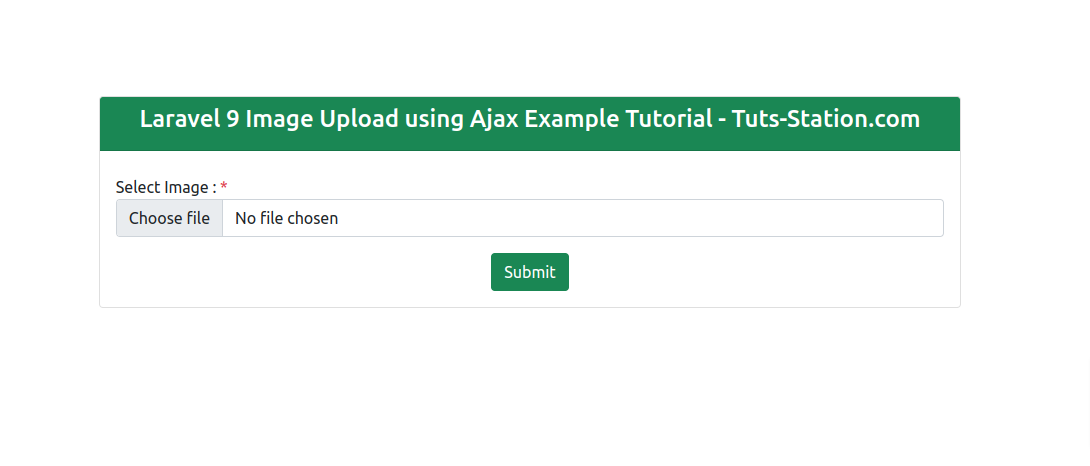
Hi Dev,
Looking to implement Laravel 9 image upload using Ajax? You’re in the right place! This comprehensive tutorial covers how to upload images via Ajax in Laravel 9 and store them efficiently into the database and file system. Whether you're building a CMS, dashboard, or user profile system — this example will guide you step-by-step through the process.
By the end of this tutorial, you'll know exactly how to handle file uploads in Laravel 9 using Ajax with validations, database interaction, and user-friendly feedback, all without refreshing the page!
Let’s get started with this practical Laravel 9 Ajax image upload example:
Step 1: Install LaravelFirst of all we are going from scratch new laravel application. if you have already created the project, then skip following step.
composer create-project laravel/laravel example-appStep 2 : Create New Migration
php artisan make:migration create_images_tabledatabase/migrations/create_images_table.php
<?php
use Illuminate\Database\Migrations\Migration;
use Illuminate\Database\Schema\Blueprint;
use Illuminate\Support\Facades\Schema;
return new class extends Migration
{
/**
* Run the migrations.
*
* @return void
*/
public function up()
{
Schema::create('images', function (Blueprint $table) {
$table->id();
$table->string('image');
$table->timestamps();
});
}
/**
* Reverse the migrations.
*
* @return void
*/
public function down()
{
Schema::dropIfExists('images');
}
};
php artisan migrateStep 3 : Create New Model
php artisan make:model Imageapp/Models/Image.php
<?php
namespace App\Models;
use Illuminate\Database\Eloquent\Factories\HasFactory;
use Illuminate\Database\Eloquent\Model;
class Image extends Model
{
use HasFactory;
protected $fillable = [
'image',
];
}
Step 4 : Create New Controller
In this second step, we need to create a new ImageController; in this file, we will add two method index() and store() for render view and store image logic.
Let's create ImageController by following command:
php artisan make:controller ImageControllerapp/Http/Controllers/ImageController.php
<?php
namespace App\Http\Controllers;
use Illuminate\Http\Request;
use App\Models\Image;
class ImageController extends Controller
{
public function index()
{
return view('index');
}
public function store(Request $request)
{
request()->validate([
'file' => 'required|mimes:png,jpg,jpeg|max:2048',
]);
if ($files = $request->file('file')) {
$filename = request()->file->getClientOriginalName();
$file = $request->file->move(public_path('images'), $filename);
$document = new Image();
$document->image = $filename;
info($file);
$document->save();
return Response()->json([
"success" => true,
"file" => $file
]);
}
return Response()->json([
"success" => false,
"file" => ''
]);
}
}
Step 5 : Create Routes
routes/web.php
<?php
use Illuminate\Support\Facades\Route;
use App\Http\Controllers\ImageController;
/*
|--------------------------------------------------------------------------
| Web Routes
|--------------------------------------------------------------------------
|
| Here is where you can register web routes for your application. These
| routes are loaded by the RouteServiceProvider within a group which
| contains the "web" middleware group. Now create something great!
|
*/
Route::get('/image',[ImageController::class, 'index']);
Route::post('upload-image',[ImageController::class, 'store'])->name('image.store');
Step 6: Create Blade File
resources/views/index.blade.php
<!DOCTYPE html>
<html>
<head>
<meta charset="UTF-8">
<meta name="viewport" content="width=device-width, initial-scale=1.0">
<meta http-equiv="X-UA-Compatible" content="ie=edge">
<meta name="csrf-token" content="{{ csrf_token() }}">
<title>Laravel 9 Image Upload using Ajax Example Tutorial</title>
<link href="https://cdn.jsdelivr.net/npm/bootstrap@5.0.2/dist/css/bootstrap.min.css" rel="stylesheet" integrity="sha384-EVSTQN3/azprG1Anm3QDgpJLIm9Nao0Yz1ztcQTwFspd3yD65VohhpuuCOmLASjC" crossorigin="anonymous">
<script src="https://code.jquery.com/jquery-3.3.1.min.js"></script>
<style>
.container{
padding: 0.5%;
}
</style>
</head>
<body>
<div class="container mt-5 pt-5">
<div class="row d-flex justify-content-center ">
<div class="col-md-8">
<div class="card">
<div class="card-header bg-success">
<h4 class="text-center text-white">Laravel 9 Image Upload using Ajax Example Tutorial - Stuffcoder.com</h4>
</div>
<div class="card-body">
<div class="alert alert-success alert-dismissible fade show successAlert" style="display:none;" role="alert">
File has been uploaded successfully
<button type="button" class="btn-close" data-bs-dismiss="alert" aria-label="Close"></button>
</div>
<form method="POST" enctype="multipart/form-data" id="laravel-ajax-file-upload" action="javascript:void(0)" >
<div class="mt-2">
<label>Select Image : <span class="text-danger">*</span></label>
<input type="file" name="file" class="form-control" id="file">
<span class="text-danger">{{ $errors->first('file') }}</span>
</div>
<div class="text-center mt-3">
<button type="submit" class="btn btn-success">Submit</button>
</div>
</div>
</form>
</div>
</div>
</div>
</div>
</div>
</body>
<script type="text/javascript">
$(document).ready(function (e) {
$.ajaxSetup({
headers: {
'X-CSRF-TOKEN': $('meta[name="csrf-token"]').attr('content')
}
});
$('#laravel-ajax-file-upload').submit(function(e) {
e.preventDefault();
var formData = new FormData(this);
$.ajax({
type:'POST',
url: "{{ route('image.store')}}",
data: formData,
cache:false,
contentType: false,
processData: false,
success: (data) => {
this.reset();
$('.successAlert').css('display','block');
console.log(data);
},
error: function(data){
console.log(data);
}
});
});
});
</script>
</html>
Run Laravel App:
All steps have been done, now you have to type the given command and hit enter to run the laravel app:
php artisan serveOutput :

I hope it can help you...